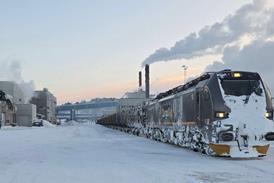A MODERATE head of steam is building up behind proposals for construction of a high speed line from London to northern England and possibly Scotland.
But supporters should be aware that many pitfalls lie ahead before a sod is turned - if indeed that moment is ever reached in a country that is incapable of building the Crossrail east-west rail link across its capital city in time for the 2012 Olympic Games - despite a bill for the scheme first being deposited in Parliament in November 1991.
An assessment of the current position is scheduled for May 8 when the Institution of Civil Engineers will stage a conference entitled High Speed Rail in the UK. The ground for this event has been prepared by a campaign group called Greengauge21, which on January 27 launched a ’manifesto’ for a high speed rail network; among the board of trustees are Railway Forum Chairman Chris Green and former SRA Chief Executive Richard Bowker.
Greengauge21 Director Jim Steer of consultants Steer Davies Gleave said that the initiative was intended to help create a body of support for a high speed network. The concept was ’bedded in thoughts about economic growth’ and the economic challenge of ’a north/south divide’ in which ’a highly successful world-class city region’ in the south contrasted with a weaker economy in the Midlands, northern England and Scotland. According to the manifesto, a high speed rail network would lead to ’an accessibility transformation’ for the regions, ’providing the necessary stimulus to local and regional economic regeneration’. Steer said that the project was ’do-able in phases’, which made the funding challenge ’a lot more manageable’.
The manifesto refers to a London - Birmingham route as ’a candidate first phase’, for which the discounted capital cost would be £8·6bn, giving a net present value of £13·3bn. Steer said that ’a high speed line in itself would produce a huge profit’, but the corollary was that it would take ’a lot of quite profitable business off the existing network’.
The obstacles facing any attempt to extend the Channel Tunnel Rail Link north of London are formidable. Perhaps the highest hurdle is the indifference and likely opposition of government, to which Steer alluded with a comment that high speed rail ’cannot happen unless politicians can see this is a no-brainer’.
Another danger lies in the considerable skills of the maglev lobbyists who will surely have sought to exert influence on former British Airways Chief Executive Sir Rod Eddington, charged by the government with reporting on the UK’s long-term transport needs after 2015 in relation to economic development. Maglev has an irresistible lure for the general media, who see it as more attractive than high speed rail - despite the fact that the world’s only operational commercial maglev route is the 31 km Transrapid project between Pudong airport and the outskirts of Shanghai. Contrast that with 6500 km of dedicated high speed railway in operation and another 2400 km under construction, excluding China (p156).
One acknowledgement that any high speed line lies well over the medium-term horizon is the programme to replace the UK’s fleet of 200 km/h high speed diesel trains dating from the 1970s which still form the backbone of inter-city services on non-electrified routes. The Department for Transport anticipates starting procurement of HST2 (RG 11.05 p707) in September in a programme with a likely price tag of £1bn. Guidelines for interested bidders published in EU documentation on February 9 say that there must be ’proper testing of a prototype’, while intriguingly, options for meeting the objective of raising capacity per train include increasing the ’length, height or width’.
- It emerged on February 15 that a private bid for London & Continental Railways, builder of the 109 km Channel Tunnel Rail Link due for completion in 2007, is in prospect. Understood to be heading the bid is former Treasury adviser and one-time Deputy Chairman of Network Rail Sir Adrian Montague.

















